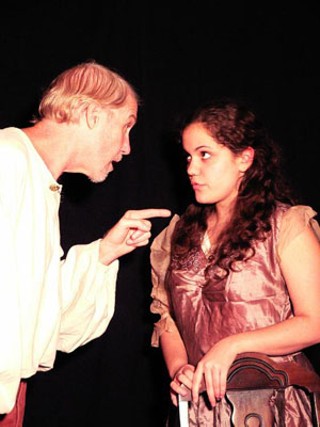One Flea Spare
Gobotrick Theatre Company's One Flea Spare is a worthwhile production of a play that's smart and crafted with a rare dexterity and elegance
Reviewed by Iris Brooks, Fri., Aug. 24, 2007

'One Flea Spare'
Dougherty Arts Center, through Aug. 25
One Flea Spare, the title taken from the amorous poem of John Donne, is an unflinching onslaught of a play. Set in London in 1665, the year of the great plague, the drama focuses on a wealthy couple, the Snelgraves, who are on the verge of fleeing London to escape the pestilence. When two intruders are discovered to have sought shelter in their cellar, the house is quarantined, and the four characters – Mr. and Mrs. Snelgrave, an orphan named Morse, and a sailor, Bunce – are trapped within its close confines. Dependent on an unscrupulous guard for food and information, the play traces the shifting social boundaries and power structures that emerge within the house over the next 28 days as the bodies pile up outside and society devolves under the plague's devastating assault.
The structure of the play, with its economy of characters and setting and its condensed time frame, is a clever variation on a classic premise – No Exit immediately springs to mind – and from this concision the playwright, Naomi Wallace, is able to address a wide swath of larger issues, which she pursues with an unhesitating relish. The 17th century, rife with disease, inequality, religiosity, and prostitution, provides her with ample material, and she makes great use of its largesse. Social injustice, pedophilia, religious hypocrisy, the exploitation of the poor, the young, the female, lust, corruption, disease, tragedy, all are brought out in fairly lurid detail. She forces the audience to confront these less-than-savory social realities with an occasionally brutal candor that, while admirable, unfortunately lacks some of the subtlety of individual experience. The poetry of Wallace's language cannot quite dispel the polemical nature of her intentions, and subsequently, the tragedies of her characters' lives remain vaguely distant and unmoving. Like many writers in a Marxist and/or feminist tradition of criticism, she is fond of metaphors of the corrupted, wounded, or otherwise maimed body. In addition to the festering sores of the plague victims, Darcy Snelgrave is covered in disfiguring burns, the sailor Bunce has an oozing wound that won't heal, and two separate mentions are made of animals on fire. This heavy indulgence in the body as metaphor reinforces the sensation that the sufferings of these unfortunates are being used to illustrate a point, a technique that in favoring the general over the specific, discourse over insight, ironically enough seems vaguely exploitative. Still, it is quite a play, and its gravitas, the impression it conveys of being grand classic drama about serious, important things, is highly satisfying.
Gobotrick Theatre Company has done an excellent job of staging this play. The spare and effective set, the elegant lighting, and the interludes of original music composed for the piece by Chris Humphrey (who also plays Mrs. Snelgrave) create a haunting environment and add an emotional resonance not otherwise present in the script. Humphrey gives a beautiful performance as the heavily scarred mistress of the house. Her slow awakening, sexually and emotionally, as her cloistered life is invaded by the child and the sailor is by far the most affecting element in the play. Sam Mercer, heavily and impressively accented as Bunce the sailor, manages to convey an appealing blend of both sexual menace and compassion. Allan Eastwood is properly dismissive as the imperious Mr. Snelgrave, and as the clear-sighted, devastatingly unsentimental 12-year-old Morse, Bethany Esfandiari successfully navigates many of the play's most uncomfortable moments. Michael Hankin plays Kabe, the thieving, lecherous sentinel watching over them all, with the unremitting vim and charm of a Shakespearean reprobate.
Director Jessica McMichael has taken great care and obviously given the material much consideration. The actors are compelling, and the play is smart, well-thought-out, and crafted with a formal dexterity and elegance that is increasingly rare.










